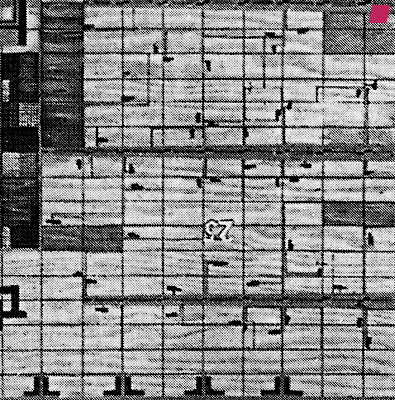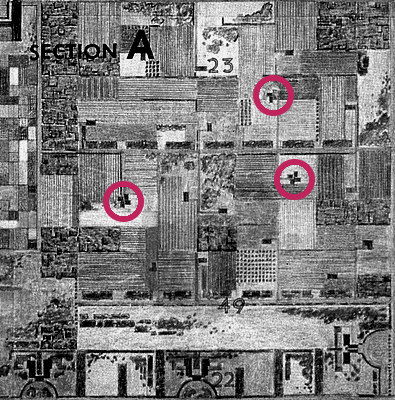| |
- 'Frank Lloyd Wright' by Bruno Zevi, published by Zanichelli Editore Bologna, 1994 [first edition 1979] http://books.google.com/
Img. _01 to the left: 'Broadacre City' plan of model published 1945 in 'When Democracy Builds'
Img. _01 to the right: 'Broadacre City' model 1934 - 35 [image rotated to match plan]
- .'FRANK LLOYD WRIGHT: DIE LEBENDIGE STADT' edited by David G. De Long, published by Vitra Design Museum, Weil am Rhein / Skira editore, Milan, 1998
http://books.google.at/
Img. _03 Detail of Broadacre City site plan, according to De Long published first in the 'Architectural Record' in 1935. Orientation of plan reproduction has been changed for comparison. [page 30]
- 'The Living City' by Frank Lloyd Wright, published by Horizon Press, 1958
http://www.archive.org/
1 » This matter (a direct continuous study beginning 1921) was first presented
as "The City" in a lecture at Princeton University. Subsequently that
lecture was published with five others by the Princeton University Press.
While in Arizona, pushed there by the national breakdown of 1929, the
Broadacre City model 12 feet by 12 feet was made by the Taliesin Fellowship.
It was first exhibited at the Industrial Arts Exposition, Radio City,
New York, April 15, 1935. This modeling is now a feature of Taliesin. « [page 219]
- 'Frank Lloyd Wright 1943-1959: The Complete Works' [Volume 3] by Bruce Brooks Pfeiffer, edited by Peter Gössel, published by Taschen 2009
http://www.taschen.com/
Img. _04 Detail of 5825.001 [page 531]
- IN: 'Center: A Journal of Architecture in America', 'Modernist Visions and the Contemporary American City' - Volume 5, published in 1989 by the Center of the Study of American Architecture, School of Architecture, The University of Texas at Austin. http://soa.utexas.edu/
'Broadacre City: The Reception of a Modernist Vision, 1932-1988' by Anthony Alofsin [pages 8 - 43]
2 [page 18] According to Anthony Alofsin the model was also on display:
at the Museum of the State Historical Library at Madison (Wisconsin),
at the department store of Edgar Kaufmann (Senior) in Pittsburgh (Pennsylvania),
at the Corcoran Gallery in Washington D.C., and later
at the Iowa County Fair (Wisconsin) and
in Marquette (Michigan);
attracting an approximate total of 70 to 80 thousand visitors in the US.
- 'Frank Lloyd Wright: Europe and beyond' by Anthony Alofsin published by University of California Press, 1999 http://books.google.at/
3 The model was part of the 'Sixty Years of Living Architecture' X.) exhibition at the Palazzo Strozzi in Florence, June 1951 [page 70 onwards]
» A large wood and plastic model of Broadacre City, cleaned, repaired, and repainted for the occasion, was the pièce de resistance of the fourth hall […] and it made a profound impression. « [page 86]
- Sdoutz 2007
Img. _02 to the left: 4 English acres compared to 4 Broad acres
Img. _02 to the right: Quarter of Broadacre City model compared to a one mile grid; Background image [most likely FLLW FDN # 3402.0089 VIII.) 4 ] of model taken from: www.wrightclub.hu (offline)
- 'Frank Lloyd Wright 1917-1942: The Complete Works' [Volume 2] by Bruce Brooks Pfeiffer, edited by Peter Gössel, published by Taschen 2010
http://www.taschen.com/
4 a See page 239 for a detailed colour reproduction of the model [3402.0089, photograph by Skot Weidemann 1993]. http://www.wright50years.com/
- IN: 'The Essential Frank Lloyd Wright: Critical Writings on Architecture' edited by Bruce Brooks Pfeiffer, published by Princeton University Press 2008 http://press.princeton.edu/
5 Excerpt from: 'A Testament' by Frank LLoyd Wright, published by Horizon Press, New York, 1957 http://www.steinerag.com/ http://books.google.at/
'Book One: Autobiographical,
Part Three: Concerning the Third Dimension'
» II Impulse to Grow
Principle two: Decentralization. The time for more individual spaciousness was long past due. 1893. I saw urban-decentralization as inevitable because a growing necessity, seeking more space everywhere, by whatever steps or stages it was obtainable. Space, short of breath, was suffocating in an airless situation, a shameful imposition upon free American life. Then, as now, the popular realtor with his "lot" was enemy of space; he was usually busy adding limitation to limitation, rounding up the herd and exploiting the ground for quick profit.
Indigestible competition, thus added to the big city, despoiled the villages. Over-extended verticality then congested to hold the profits of congestion was added to the congestion already fashioned on the ground.
To offset the senselessness of this inhuman act, I prepared the Broadacre City models at Taliesin in 1932. The models proposed a new space concept in social usage for individual and community building. But the whole establishment was laid out in accordance with the conditions of land tenure already in effect. Though the centers were kept, a new system of subdivision was proposed.
Later, this model of the broader use of ground for a new idea of a new city was carefully studied in detail in a series of smaller tributary models, all as described in When Democracy Builds, a book I later wrote on the suggestion of Robert Hutchins. Buildings, roads, planting, habitation, cultivation, decoration, all became as architectural as they were in Umbria in Italy in the Middle Ages; qualities of ancient sort in modern form for modern times, considered in terms of modern humane utility. Thus broadened, the view of architecture as basic now in service to society came as relief and gave a preview of primary form facing the law of the changes inevitable.
Therefore quantity - the machine source - was in no way, nor anywhere, at any time, to be used to hinder the quality of new resources for human profit and delight in living. Living was to be a quality of man's own spirit.
Science, the great practical resource, had proceeded to date itself and magnify the potential sacrifice of man as menial, now wholesale destruction of democracy. Congested in cities by continually bigger mechanical means to avoid labor, man was to be given a new freedom. The ground plan of Broadacre City was bound together in advantageous, interactive relationship to the new resources of human life under protected freedom, our own if only we would reach out and take it.
Convenient, inspiring continuity appeared in this plan for a new community (still called a city), inevitable to the survival of human individuality. But I have learned that a new pattern can never be made out of the old one: only palliation is possible - and is soon inefficient. These initial Broadacre City models, still to be seen at Taliesin, were exhibited at Rockefeller Center, New York, 1934, [actually 1935] and many times since, elsewhere in our country and abroad. Notwithstanding the A.I.A. and the critics, this complete group-model, new in concept and pattern, showing the new life of agrarian - urbanism and urbanized - agrarianism, virtually the wedding of city and country, reappeared to travel around the world in the exhibition "Sixty Years of Living Architecture." After being shown in Philadelphia, Florence, Paris Beaux - Arts (where I was told this was the only one - man exhibition since the one accorded to James McNeill Whistler), Zurich Art Institute, Munich Art Palace, Rotterdam Civic Center, University of Mexico, it returned to a special exhibition building in New York City, and later to a special extension of Olive Hill in Los Angeles by the Municipal Art Society. « [page 427-429]
- 'Sixty Years of Living Architecture: The Work of Frank Lloyd Wright' by Frank Lloyd Wright, published by The Solomon R. Guggenheim Museum, New York 1953 Catalogue to an exhibition
» on the grounds that would eventually become the Guggenheim Museum. « from 22. October to 29. November 1953 [According to http://www.steinerag.com/ the international exhibition dedicated to Wright's work travelled from 1951 to 1956 VI.) 3 ] http://www.guggenheim.org/ http://www.steinerag.com/
6 » Broadocre City was finally modelled in 1932 as a Taliesin Fellowship project. That original model is now included in this exhibition. From this over-all model these views have been taken. The model is based upon the theory of Decentralization - feeling that centralization of intense and growing urbanization has done its work and our modern techniques must have freedom to become truly advantageous. This freedom can be secured only by going forward to more intelligent use of man's heritage - the ground. Life in these United States - by nature - is more agrarian than industrial if our great gift of ground is to mean what it should mean to the human being. Broadacre City was a study in that direction - the democratic ideal of freedom of the individual here finds an architecture more suited to its future life than any urbanization can now afford. « [page 17]
Continued in the inventory:
» 51. BROADACRE CITY.
Model. A conception of the ideal modern decentralized community. Scale of the model: 4 square miles. This area includes 2200 one-acre plots. Protesting against the exaggerated and inhuman concentration in American cities, Broadacre City is designed for the direct contact of man with nature and the countryside. His birthright is re-established; the wide, open spaces are appropriately built upon. Thus the "urbanized countryside" is born as a new type of city - one adapted to individual living.
Panels illustrating the principles of organic architecture are set up alongside the model. Entire plan of Broadacre City indicating the most important buildings may be seen in "When Democracy Builds" (Chicago University Press). Ideas for the "new freedom" of living are embodied in collateral models not included in this exhibit.
« [pages 33-34]
|
!['Broadacre City' plan of model 1945 and 'Broadacre City' model 1934 - 35 by Frank Lloyd Wright, from 'Frank Lloyd Wright' by Bruno Zevi published by Zanichelli Editore Bologna, 1994 [first edition 1979] 'Broadacre City' plan of model 1945 and 'Broadacre City' model 1934 - 35 by Frank Lloyd Wright, from 'Frank Lloyd Wright' by Bruno Zevi published by Zanichelli Editore Bologna, 1994 [first edition 1979]](content/frank_lloyd_wright_1934-35_broadacre_city_plan_model.gif)
![English acres and Broadacre model compared to a one mile grid [Sdoutz 2007] English acres and Broadacre model compared to a one mile grid [Sdoutz 2007]](content/broadacre_grid_overlay_800.jpg)








TOP
Social Networks